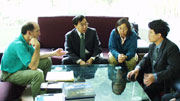|
 From 1991 to 1992, the Volunteers' Organization of the UN sent the Stuart Chapman family to the Administrative Bureau of the Wolong Natural Reserve. They assisted in the protection and administration of the reserve. In 1993, the Volunteers' Organization of the UN sent Dr. Galen and his wife to Wolong to continue the work of Mr. Chapman. Due to coordination problems among different departments of the reserve, the couple went back to Canada one year later. From 1991 to 1992, the Volunteers' Organization of the UN sent the Stuart Chapman family to the Administrative Bureau of the Wolong Natural Reserve. They assisted in the protection and administration of the reserve. In 1993, the Volunteers' Organization of the UN sent Dr. Galen and his wife to Wolong to continue the work of Mr. Chapman. Due to coordination problems among different departments of the reserve, the couple went back to Canada one year later.
From 1992 to 1993, the center cooperated with Dr Allen from New York Animal Nutrition Center and Nancy Cooper, an expert in endocrinology from Zoological Society of San Diego and respectively studied giant panda nutrition and its application, and the change of hormone level caused by immune technology.
From 1980 to 1993, independently and cooperating with foreign researchers, researchers in the center observed and studied the wild giant pandas in the reserve for 14 years by using neck-ring-shaped mini signal sender and receiver or just by tracing the footprints and animal excrements. The study indicates that the population of giant pandas remains table. And the result of the research has been directly applied in the protection project of giant pandas in China and other scientific researches.
The center cooperated with the National Institutes of Health to do research on parentage identification of the giant panda through its hair. Research papers on that research have been published.
The center cooperated with the Zoo Association of San Diego to do researched on the behavior, physiology, hormone and diseases of the giant panda.
Cooperating with PhDs from Berkeley, the center conducted research on the living habits and species competition of giant pandas and black bears in the Wolong area.
The center cooperated with University of Michigan and the Institute of Ecology of Chinese Academy of Sciences to conduct research on the application of GPS in the Wolong Natural Reserve.
In recent years, we have cooperated with Kobe Prince Zoo of Japan, San Diego Zoo and Washington Zoo on scientific researches of the reproduction and breeding of the giant panda. Several research members have been sent to study or work in Japan and the U.S., and dozen of foreign experts have been received.
Meanwhile, the center also did training to animals keepers on the feeding, behavior observation and disease treatment of the giant panda.
Since it first cooperated with CBSG, the center has introduced advanced equipment to do comprehensive and careful examination on giant pandas in Wolong. The examination has provided clues for the keeping and disease treatment of giant pandas.
The center cooperated with University of Michigan and the Institute of Ecology of Chinese Academy of Sciences to conduct research on the application of GPS in the Wolong Natural Reserve. In the research, more than 200 quadrats have been selected and 2 GPS stations have been built. This has laid a firm basis for future investigation on wild plant and animal resources.
Together with WWF, the center conducted observation and monitoring on wild giant pandas and the behavior of manually-bred giant pandas.
Cooperation with the World Wildlife Fund (WWF)
Domestic Cooperation of the Research Center
|



